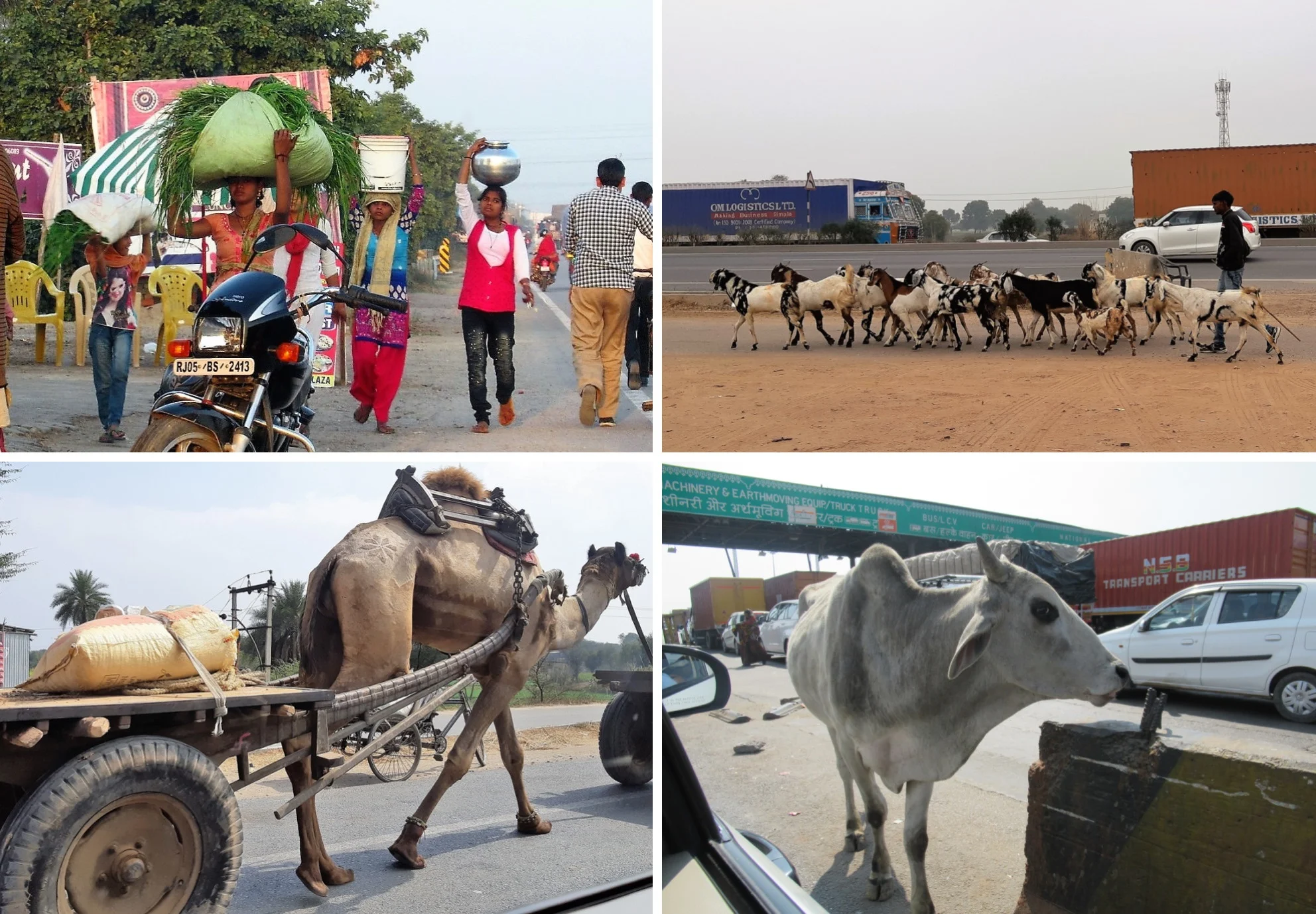After our interesting time in Delhi, we were
headed to Jaipur in a car with a dedicated driver. We were
looking forward to seeing the rural towns along this 5-hour route. But the highway traffic was intense - cars were
weaving in and out of lanes at high speed, while beeping madly.
The aim was to get past tutktuks travelling at
a snail’s pace in the high-speed lanes; rusty trucks with leaning loads;
clusters of women balancing baskets on their head; herders with their assorted flocks, and
slow-moving drays.
The road was full of potholes and on a two-lane highway going one-way, there was generally four lanes of traffic.
However, our driver was fantastic; he was very
accomplished and we felt quite safe. It’s not the way we do it at home in New Zealand, but you
have to have faith in the system and go-with-the-flow!
So we leaned back and enjoyed the ride, with
not a white knuckle in sight.
The rural towns we passed through all looked
remarkably similar with the same kinds of open stalls and small business
activity.
Soon we arrived in Jaipur, a large city and the
capital of Rajasthan. It is also known as the pink city, as we found out later.
Our accommodation, Hotel Rajputana Haveli, is located in a quiet side street on the edge of the ‘old
city’. It is very quaint, with welcoming staff.
After checking in, our driver took us for a
short trip to the Old City Palace. This is an imposing place which has several
beautiful marble pavilions.
There were quite a few monkeys around, but a
helpful chappie kept chasing them off. In fact there were monkeys everywhere in
Jaipur, and the little blighters toss things at you from time to time.
One night, we were entertained by a large monkey that
climbed up to the 3rd floor balcony of an apartment opposite our hotel. He
helped himself to water from the birdbath before taking off again.
Later, we took ourselves out for a walk. Heading into the centre of the city, we negotiated broken footpaths and chaotic traffic, to enter through one of the attractive pink city gates. But we didn't venture far as it was beginning to get dark, and we had to find our way back to the hotel.
The next morning, a guide met us at the hotel and took us to our
first stop in Jaipur, the Amber Fort. It is a UNESCO Work Heritage site.
This Fort is surrounded by imposing walls and
watch towers. During its many years and many wars, this wall was never breached.
It is an amazing complex, where one the Rajput
rulers lived. It was commenced in 1592 and grew over many years to become an extensive palace-like fortress. It features pale yellow and pink sandstone, and
white marble. We found it to be a very interesting and attractive place to explore.
We chose to drive up to the fort, but one way of getting up to there was by
elephant. At the top, we spotted many people arriving on elephants that had painted rumps and faces.
 |
| Painted elephant at the Amber Fort, and working elephant in streets of the city, Jaipur (UNESCO) |
On the drive down from the Fort, we were
amazed by the number of elephants being used for day-to-day activities in the village at
the base of the Fort. They just wandered along doing their job,
seemingly undeterred by the cars and motorbikes whizzing around them.
Jaipur is called 'The Pink City' because in India, pink is
the colour of hospitality. Apparently, when the Prince of Wales, Albert Edward visited in 1853, Maharaja Ram Singh had the whole city painted pink to welcome him.
A great example of the pink architecture is the Hawa Mahal,
Palace of the Winds, which has the most detailed façade - in pink of course.
We then visited the Albert Hall, built for the
Prince of Wales visited in 1876. It is a museum now but is also a roost for
pigeons - there were thousands of them.
We have never seen so many pigeons on a
building before. People feed them because they believe you get good karma from
feeding birds and animals (hence the many monkeys about too!).
We also visited the City Palace which is the seat of the Maharaja of Jaipur. It is a wonderful example of art and architecture coming together in a complex of beautiful gardens and courtyards.
Another stop was to the Jantar Mantar, another UNESCO World Heritage Site. This is a collection of 19 huge astronomical instrument that
includes the world’s largest stone sundial.
Built by the Rajput king Sawai Jai Singh II, the founder of Jaipur, it was completed in 1734.
 |
| The vrihat samrat yantra (the world's largest sundial), Jantar Mantar, Jaipur (UNESCO) |
The instruments are used for measuring time, predicting eclipses, tracking the location of major stars as the earth orbits around the sun, ascertaining the position of planets, and determining the celestial altitudes.
We thought it was an amazing place to wander
around.
The above is part of our 2-month tour of India. The first blog on this tour is called "Off to Delhi"






